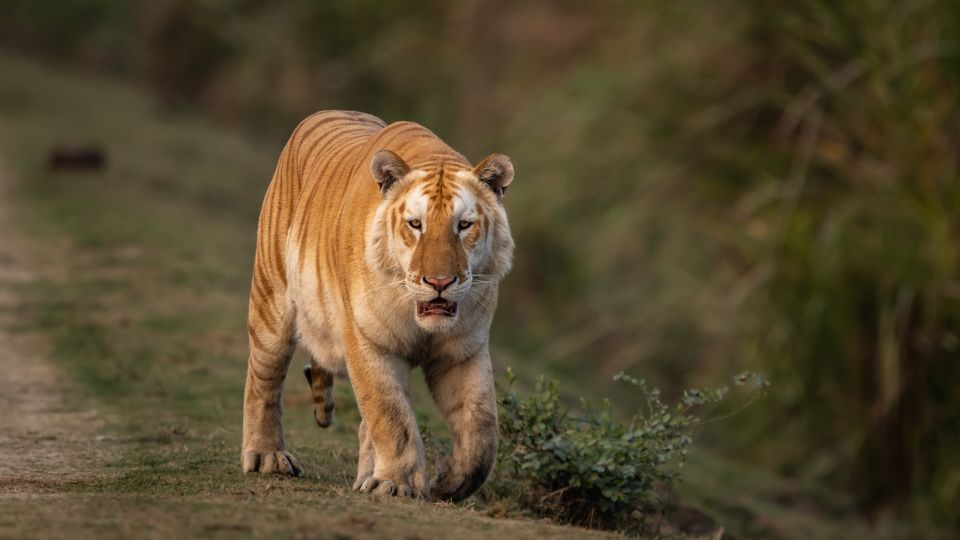Why a rare ‘golden’ tiger photographed in India is worrying conservationists
When tour guide and wildlife photographer Gaurav Ramnarayanan set out on safari on the evening of January 24, 2024, he wasn’t looking for tigers.
The 25-year-old was leading a private tour in the UNESCO World Heritage Site of Kaziranga National Park, a 430 square-kilometer wildlife reserve in India’s northeastern Assam state. While it’s home to the largest tiger population in the region, sightings are rare and the park is better known for its other wildlife, including the world’s largest population of one-horned rhinoceroses and hundreds of colorful bird species.
That’s what Ramnarayanan and his tour guests were looking for that night. Sitting in the safari jeep in the late afternoon, the group suddenly heard an alarm call from a deer — the sound an animal makes when it sees a predator, says Ramnarayanan. He began driving, turning a corner before stopping the car in its tracks: around 700 meters away, there was a tiger on the road.
“Initially when I saw him, he looked really white and didn’t look like a normal (Bengal) tiger,” says Ramnarayanan, who has been guiding wildlife tours and photographing big cats since 2016, when he founded his travel company The Wildside. “I’ve seen enough tigers to realize at the first glance that this one was not regular.”
His suspicions proved right when he looked at the predator through his camera lens: with strawberry-blonde stripes, the big cat was unmistakably a rare “golden” tiger.
“The tiger decided to come towards us, not with any intention for attack or any intention to harm us, but purely to pass through his path and proceed with marking his territory,” says Ramnarayanan. He was able to snap incredible shots of the tiger as it walked along the road, coming within 100 meters of the jeep.
Ramnarayanan posted an image online, and internet users were quick to express their admiration for the stunning photo and the tiger’s unusual coloring.
But golden tigers — also known as golden tabby tigers or strawberry tigers — are not a subspecies: they’re the result of a genetic mutation that changes the color of their fur.
And while beautiful, their presence has a dark side.
Genetic “spelling mistakes”
Golden tigers, like white and snow-white tigers, are the result of a recessive trait that appears as a mutation in color-creating genes, says Uma Ramakrishnan, a professor of ecology at India’s National Center for Biological Sciences.
She likens the mutation to “spelling mistakes in the DNA” that result in different color combinations. In white tigers, the mutation inhibits color, while in golden tigers, a mutation in the so-called “wideband” gene extends the production period of pheomelanin, a reddish-yellow pigment, during hair growth. Snow-white tigers inherit both recessive traits, giving them a white coat with barely visible blonde stripes, giving them the nickname “stripeless tigers.”
In the wild, less than one in 10,000 tiger cubs are born with the white fur trait, and the golden trait is even rarer.
That’s why conservationists are concerned that the appearance of these tigers could be a symptom of inbreeding in isolated tiger populations.
It’s more common to see these unusual fur patterns in captive tiger populations, which are often related to each other, says Ramakrishnan. Historically, white tigers have been bred selectively for these genes, often with their offspring — which is why, while there are currently no known white tigers in the wild (the last one was reportedly spotted and shot in the 1950s), there are over 200 in captivity around the world.
While the irregular fur coloring isn’t known to have adverse health effects, inbreeding can cause physical ailments including a flat face or crossed eyes, as well as other genetic mutations that could weaken the tiger’s defense against diseases, says Ramakrishnan.
There’s an estimated 30 golden tigers in captivity around the world, according to some sources, and Kaziranga National Park claims it has four, the only known ones in the wild.
Given the exceptional rarity of this trait, “the only way it would show up,” says Ramakrishnan, is through inbreeding or genetic drift, which is when rare genes become more common by chance — something that’s still being studied.
Fragmented populations
Golden tigers have been spotted in Kaziranga since 2014, and Ramnarayanan isn’t the only one to have captured them on camera: in 2020, Mumbai-based photographer Mayuresh Hendre shared photos from a safari in Kaziranga online, which caused a stir on the internet then, too.
While it’s a unique selling point for visitors, the park is not celebrating: in a statement posted on the park’s X account (formerly Twitter) in 2020, Kaziranga research officer Rabindra Sharma said the “recessive genes are showing up due to inbreeding within a fragmented population.”
Around 70% of Assam’s 190 tigers reside in Kaziranga, but rapid development in the region means wildlife is losing its historic migration routes between habitats. A 2020 study documented increasing fragmentation and a loss of forest corridors around the park. If Kaziranga’s tiger population becomes more isolated, issues like inbreeding will threaten the population, said Sharma in his post on X.
The region’s alluvial grasslands, which attract tiger prey, and stringent law enforcement that cracks down on poaching and hunting, have made Assam one of the “most productive habitats for tigers” in northeast India, says Kota Ullas Karanth, a conservationist and founder of the Centre for Wildlife Studies in India. However, the unusually high number of golden tigers in the park is indicative of an isolated population and a worrying sign, he adds.
“Better habitat connectivity between populations, by promoting land uses that encourage long-range movements of tigers” is the “key factor” to building a more resilient, genetically diverse tiger population, says Karanth. “In a few cases, structures such as bridges and tunnels placed across risky or difficult-to-cross habitats may also help.”
While insularity could lead to reduced genetic diversity, “poaching and habitat degradation pose more imminent threats to tigers in India than genetic isolation,” says Karanth, adding that “buffering of reserves with more favorable land uses such as tourism, rather than conflict-prone agriculture and livestock raising,” is more urgent.
For photographer Ramnarayanan, Kaziranga’s golden tiger was his first sighting of these unusually colored big cats. Striking as it was, he’s conscious of the rarity, and hopes he can spark conversations about how to better protect wildlife. “As a photographer, I can bring messages out to the public,” he adds.
For more CNN news and newsletters create an account at CNN.com












 Bitcoin
Bitcoin  Ethereum
Ethereum  Tether
Tether  XRP
XRP  USDC
USDC  TRON
TRON  Lido Staked Ether
Lido Staked Ether  Dogecoin
Dogecoin  Figure Heloc
Figure Heloc